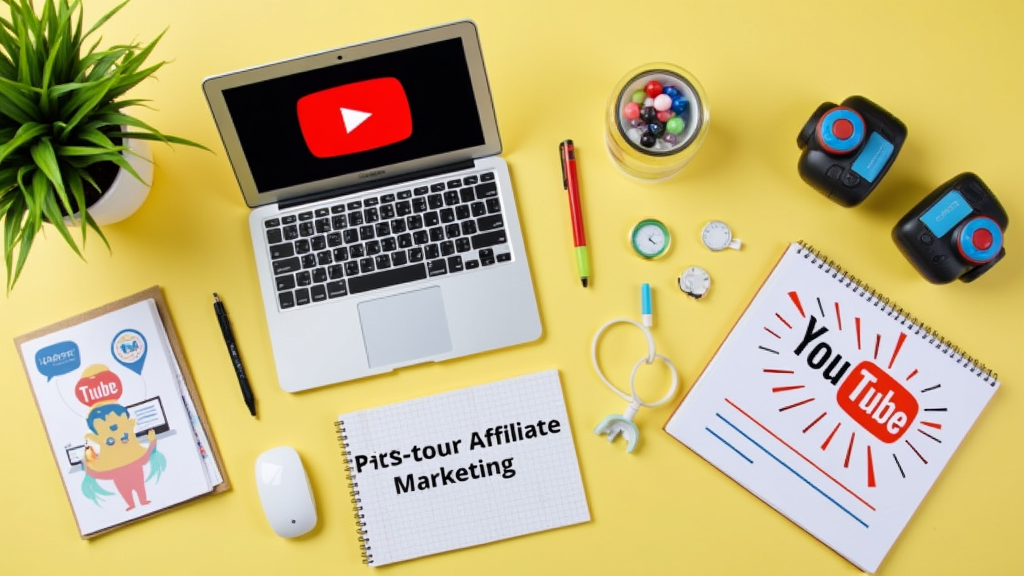YouTube is a seriously powerful platform when it comes to affiliate marketing. Video content gets tons of attention, and with billions of users watching YouTube videos every month, anyone who wants to earn through affiliate marketing should at least consider it. Promoting products with videos creates genuine engagement, and it’s easier than most people think to get started.
Even if you’ve never recorded a video before or have no budget for fancy equipment, YouTube can be a great way to build a following and earn extra money through affiliate links. The best part? You don’t need a massive subscriber list to see results. Consistency, value, and a bit of creativity go a long way.
I’ll walk you through what makes YouTube such a great fit for affiliate marketing, how you can get started, practical steps to follow, and helpful tips I’ve picked up through my own work on the platform. Whether you’re aiming for a side income or want to grow something bigger, you’ll find useful advice here for every stage.
Why Use YouTube for Affiliate Marketing?
YouTube stands out for affiliate marketers for a few reasons. People trust video creators more when they can see and hear recommendations directly. It’s a lot easier to show a product’s features, answer questions, and prove how it works in real time. If you like explaining things, sharing experiences, or just showing cool finds, video reviews or tutorials can lead viewers straight from your video to your affiliate link.
- Huge audience: Billions of people use YouTube every month, and many are looking for product reviews or recommendations.
- Longer engagement: Viewers spend more time on videos compared to scrolling quick blog articles or social posts.
- Evergreen content: A good video can rank in search engines as well as Youtube’s search feature, and keep earning affiliate income for months, sometimes even for years after you upload it.
- Visual proof: People like to see real results and demonstrations before they click an affiliate link and commit.
Plus, the YouTube algorithm loves helpful content, which is exactly what affiliate videos can offer. You can grow at your own pace, work from anywhere, and build up a channel that becomes a real asset over time. For affiliate marketers, that means videos you upload today might keep delivering results months down the road.
Getting Started with YouTube Affiliate Marketing
You don’t need pro equipment or on camera skills to get going. Most people start with their phone or a basic webcam, focusing on honest reviews or useful how to content around products they genuinely like. Picking a clear topic or niche helps, but it’s fine to experiment a bit at the start to see what works for you.
Quick checklist to start:
- Choose a clear niche (affiliate products, tech gadgets, home products, beauty, finance, etc.).
- Sign up for affiliate programs that match your interest.
- Set up your YouTube channel with a simple logo, header, and description.
- Plan your first few video ideas (product reviews, tutorials, comparisons, or unboxing videos all work well).
- Get used to speaking on camera. Practice by recording yourself and watching it back. This helps reduce nerves and makes your delivery smoother.
- If you don’t want to appear on camera, that’s fine. You can use slides, etc. with a voiceover.
You won’t need any paid software in the beginning. Free editing apps like iMovie on Mac or Clipchamp on Windows are quite handy. Thumbnails don’t have to be fancy, but try to make them eye-catching. Most viewers decide what to watch based on the thumbnail alone, so spend a few minutes making titles and images that pop.
You should create a simple script or outline before you record, to keep your videos focused and clear. As you build confidence, it becomes easier to speak naturally on camera.
Step by Step Guide to Using YouTube for Affiliate Marketing
- Pick products you know and trust: Stick with things you’ve used or thoroughly researched. Your reviews will sound more authentic.
- Create useful content: Focus on questions viewers are already searching for. “Does this product really work?” or “How do I use it?” are pretty common themes. Find their “Pain points.”
- Record and edit your video: Good lighting and clear audio make a big difference. Most phones are up to the job these days. Edit out mistakes but don’t sweat perfection. Natural videos can connect more with viewers.
- Add your affiliate link: Place your link near the top of the video description. Always add a quick disclosure so people know it’s an affiliate link. YouTube requires this, and it helps build trust with your audience.
- Optimize for search: Use keywords people might look for in your video title, description, and tags. For example, “Best Wireless Earbuds 2025 Review” works better than something vague.
- Promote your videos: Share your link on social media sites like in Facebook groups (when allowed), or your own blog if you’ve got one. The more places your video is seen, the more chances people have to click your affiliate links.
Example video ideas that work:
- Product unboxing and first impressions
- Side by side comparisons between two similar products
- How to guides using the product
- Honest pros and cons lists
- Buyer’s guides for beginners
You can also create follow up videos after using a product for several months, or FAQs based on questions from your viewers. This helps build both trust and long term engagement with your audience.
Consistency is Key to Growth
Uploading regularly is really important for getting noticed on YouTube. The algorithm tends to reward creators who show up often, and viewers are more likely to subscribe if they know you’ll post the kind of videos they want to watch. Some people start with one video a week, others aim for two. Setting a realistic schedule keeps things manageable and helps you avoid burnout.
- Plan a content calendar so you don’t run out of ideas.
- Keep track of which videos get the most views, and focus more on those topics.
- Small improvements each time (editing, audio, titles) really add up. Over time, you’ll notice your videos get better and attract more viewers.
- Set up analytics tracking for your links to measure performance. Bitly.com is a good, free place to start.
- Youtube provides it’s own analytics tracking for views, watch-time, etc.
Don’t get discouraged by low views in the beginning. Growth is often slow early on, but old videos can suddenly take off months later. The trick is to stay consistent and keep learning from what works and what doesn’t.
It’s also helpful to watch similar channels or competitors to spot trends and see what’s working for others in your niche. You might get inspiration or find gaps you can fill with your own content.
Best Practices for YouTube Affiliate Marketers
- Be genuine and honest: People can spot fake enthusiasm a mile away. If you have doubts about a product, say so. Your viewers will respect you more.
- Always disclose affiliate relationships: A simple “the links below help support my channel” works fine. It’s required and helps build trust.
- Respond to comments: Answering questions builds community and can encourage viewers to use your links.
- Use timestamps and chapters: They help viewers find what they want, especially in longer reviews. Adding chapters in video descriptions is a quick way to help viewers jump to the info they need.
- Experiment and keep learning: The YouTube algorithm and audience tastes change all the time. Try new video styles and keep an eye on analytics. Don’t be afraid to switch things up if something isn’t working.
Expectations and What to Watch Out For
Success with affiliate marketing on YouTube doesn’t happen overnight. Early videos might only get a few views at first, and earnings build up slowly. Some affiliate programs have minimum payouts or other requirements you’ll need to pay attention to. That’s pretty normal, and it’s worth sticking with it if you’re serious about earning online.
Things to expect:
- First commission payouts can take a while
- Subscriber numbers may grow slowly at first
- Negative comments or dislikes happen, but don’t take it personally…respond honestly and respectfully.
Common issues to avoid:
- Spamming affiliate links in comments or unrelated videos. YouTube frowns on this and it could get your channel flagged.
- Breaking platform rules by not disclosing links clearly
- Promoting low quality or scammy products just for a higher payout
Staying patient and helpful builds a loyal audience that’s much more likely to use your links and recommend your channel. Trust is everything in affiliate marketing—protect it every step of the way.
You may want to regularly review the affiliate programs you use, and switch out links or product recommendations as needed. Keeping content up to date shows viewers you care about their experience and can boost your channel’s reputation.
Quick Answers to Common YouTube Affiliate Questions
How do I get approved for affiliate programs?
Most programs only need a YouTube channel and some basic info, but a few require a certain number of subscribers or views. Starting with Clickbank, Amazon Associates, ShareASale, or Impact is usually pretty easy for beginners. Be sure to read each program’s terms so you know what’s required to get paid out.
Do I need thousands of subscribers to earn money?
Nope! Many marketers get regular commissions from less than 1,000 subscribers. Focus on helpful content that solves a problem. People click helpful links, not just popular ones.
What about copyright?
Stick to your own footage, music from YouTube’s free library, and avoid using copyrighted material from other channels in your reviews or tutorials. YouTube could demonetize or even remove your videos if you break the rules, so it’s important to play by the book.
Also, check the terms for all the affiliate programs you join. Some have specific rules about where you can share your links, so staying informed lowers any risk of being dropped from a program.
Building Your Affiliate Marketing Channel on YouTube
Starting a YouTube channel for online marketing and affiliate marketing is straightforward if you focus on giving viewers real insight into products and stick with it over time. Plan out a handful of video ideas, record with whatever gear you have right now, and aim for improvement rather than constant perfection.
First steps you can take:
- Pick 1 or 2 products you know well and create your first review or how to video.
- Add your affiliate link with a short disclosure right in the description.
- Upload weekly or biweekly videos to build traction; consistency helps a lot.
YouTube can become a side hobby or a steady affiliate income stream if you stick to honest reviews, listen to your viewers, and keep learning as you go. Choose a niche you care about, be patient, and see where your channel can take you. With persistence, your channel could become a real source of ongoing income and personal satisfaction.
For more indepth training about video marketing on Youtube and anything else related to online marketing, be sure to bookmark this website and consider joining Wealthy Affiliate. It’s my no. 1 recommendation for indepth affiliate marketing training. And, you can get started for free! Good luck and happy filming!
Go Here To Get Started In Wealthy Affiliate For Free
I hope you enjoyed today’s article. Feel free to leave a comment below.
Until next time,
Greg Hoyt
Disclosure – The links in my articles help support my channel






I’ve used YouTube in affiliate marketing for a couple of years now, and one thing that’s worked well for me is creating tutorial-style videos where I genuinely use the product on camera. Audiences respond better when they can see how something actually works rather than just hearing a pitch. I’ve also found that shorter videos with a clear structure: problem, solution, then recommendation, tend to convert better than longer, less focused content. Keeping affiliate disclosures transparent has built more trust over time, which I think is key to sustainable success.
Great advice, Slavisa! That’s great feedback for all of us. Thanks!
Great article, Greg. I’ve actually posted a few general videos on YouTube before and was surprised by how quickly they picked up views—one even got a lot in just a single day. But I never added affiliate links at the time because I didn’t really understand how that worked. After reading this, I can see how I could’ve turned that traffic into something more. Your step-by-step breakdown makes the whole affiliate side of YouTube feel way more doable, even for someone like me who hasn’t tried it seriously yet. Definitely gave me some ideas!
Great, I hope it helps you feel more confident adding it to your online marketing efforts.
Yo Greg,
Dude, your YouTube affiliate marketing guide is straight fire! It’s like having a personal hype man showing me the ropes step by step.
I dig how you keep it real about being genuine and giving people actual value. It’s not about making a quick buck, but building a squad that trusts you for the long haul. That’s the secret sauce right there!
Your tips on making videos pop in search, using chapters, and replying to comments are legit. You clearly know what’s up and wanna help peeps succeed. Mad respect!
And can I just say, the way you write is so hype and motivating! It’s like chatting with a homie who knows their stuff and is cheering you on. Your vibe is on point!
I’m feeling the honesty about the challenges and potential roadblocks too. It’s refreshing to see someone keep it instead of just hyping up the easy parts.
Thanks for putting together such a sick guide. I’m definitely bookmarking your site and checking out Wealthy Affiliate. With your advice and their training, I’m way more stoked to start my own YouTube affiliate journey. Let’s get it!
Keep killing it, Greg! You’re making a real difference for aspiring hustlers like me. Can’t wait to see what you drop next!
Peace out,
Eric
Thanks Eric, I appreciate your kind words
I really like the section on Step by Step Guide to Using YouTube for Affiliate Marketing, really stood out as a practical roadmap for beginners. I appreciate how it breaks down complex tasks like video creation and SEO optimization into manageable steps, making the whole process feel much less intimidating. The emphasis on choosing products you genuinely trust also highlights the importance of authenticity, which is crucial for building long-term audience trust. I’m curious about two things how important is investing in better equipment as a channel grows, especially for improving video and audio quality? Also, what strategies work best for promoting affiliate videos outside of YouTube to maximize reach and clicks?
Hi Ravin,
I appreciate your feedback. As the audience of the Youtube channel grows, it would make sense to make audio and video equipment improvements. But, until that point, a mobile phone can do a respectable job. Outside of Youtube, there are many other avenues that videos can be used for, such as social media posts, landing pages, etc. I wrote an article on that recently. You can see it here: https://onlinemarketingsource….
Greg
This was such a practical and motivating guide, Greg—thank you for breaking it all down in such an easy-to-understand way! I especially appreciated your reminder that you don’t need fancy equipment or a big subscriber base to start seeing results. So many beginners feel intimidated by video content, but your tips show how approachable it can be with the right mindset and consistency.
One part I found particularly helpful was the emphasis on being genuine and providing real value. In a space where so many creators push products just for commissions, your advice to build trust and stay transparent really stands out. Quick question—have you found certain affiliate niches perform better than others on YouTube, especially for creators just starting out? Or should beginners focus more on passion and familiarity over profitability at first?
Hi Jason,
Thank you for the feedback. It works similarly for most if not all niches. Deciding which niche to choose is always the age old question. It’s up to each person to make that choice.
Greg
This post really hits the mark—thank you for laying out the steps so clearly!
I’ve been doing affiliate marketing for a while now, mainly through blogging, but I’m in the early stages of launching my YouTube channel to expand my reach. It’s encouraging (and honestly, a bit relieving!) to see how repurposing blog content into video is not only doable but actually a smart move. That’s exactly what I’m planning to do as I get started.
I especially appreciated the section about including disclosure and staying compliant. It’s something I’ve seen many new affiliates overlook, and it’s good to see ethical practices emphasized.
One tip I’d add based on my blogging experience: integrating a call-to-action that offers value first (like a freebie or tip before linking to the affiliate) can really increase trust and conversions—especially when building a new audience on YouTube.
Hi Alyssa,
Thank you for your comments. I’m sure you’ll be successful as you expand your marketing onto Youtube. I’m intrigued by, and I’m sure others will be too, regarding your suggestion to offer a freebie or tip prior to the affiliate link. Can you explain what that would look like and what type of freebie or tip would you suggest?
Thanks again,
Greg
Thanks @greg, great post. I found it really helpful — the step-by-step breakdown makes YouTube affiliate marketing feel way more approachable. Loved the emphasis on building trust through content before dropping links — that’s a strategy too many overlook – and when I see that I shy away immediately from their content.
The tips like optimizing titles and thumbnails were spot-on as well. I am curious if there’s a sweet spot for video length when it comes to successful affiliate conversions?
Thanks for the clear and actionable guide/run-sheet for YouTube.
MarkA
Hi Mark,
I try to keep my Youtube videos between 6 – 12 minutes. That way they’re long enough to build trust, provide content or demonstrate a product, and insert your call-to-action and/or affiliate link naturally. If they’re too long viewers will start dropping off quickly.
Also, be sure to place your affiliate link in both the description and a pinned comment.
For YouTube Shorts, TikTok & Reels try to keep them between 30–60 seconds. Viewer attention is much shorter in those. Use text overlays and strong visuals to grab attention fast.
Hope that helps.
Greg
Thanks for sharing this guide. It is very useful to know how YouTube can work with affiliate marketing in a simple way. The way it explains different video types and ways to make money is clear and easy to use. I liked seeing real examples of content that works well.
It’s good to get advice that is straight to the point and simple to follow. I will save this to look at again when I start to plan my own YouTube affiliate projects.
Israel
Hi Israel,
I’m glad you found the article useful. I wish you well in your efforts to start utilizing Youtube in your marketing efforts.
Take care,
Greg
Greg, this is a fantastic and in-depth guide for anyone looking to dive into YouTube affiliate marketing. I really appreciate how beginner-friendly your approach is—you make it clear that expensive gear or a huge following isn’t necessary to get started. Your emphasis on authenticity, consistency, and providing value really stood out, especially in a space where people often chase quick wins. The practical tips like using timestamps, optimizing thumbnails, and regularly reviewing affiliate programs are super helpful. I also liked your reminder that trust is key in building a sustainable channel. The step-by-step format and example video ideas make it easy to take action right away. Thanks for including advice on handling slow growth and staying patient—it’s realistic and encouraging. Definitely bookmarking this one. Great job and much appreciated!
Thank you, Andrejs. I’m glad it was helpful. I try to lean towards beginners with my content, because I remember how challenging it was to get the right information when I was first starting out.
Greg
This is one of the most practical and motivating guides I’ve read on using YouTube for affiliate marketing—great job! I completely agree that you don’t need pro-level gear or a massive audience to get started. I’ve personally seen small, well-optimized channels consistently bring in commissions just by offering honest product reviews and helpful content.
One thing I’d add from my own experience is how powerful it is to focus on “buyer intent” keywords in your video titles and descriptions—phrases like “best [product] for beginners” or “is [product name] worth it?” tend to attract viewers who are already close to making a purchase decision. Pair that with a clear affiliate link and a genuine recommendation, and it can lead to some solid conversions over time.
Also, I really appreciate the reminder to stay consistent. YouTube is definitely a long game, but the passive potential from evergreen videos is so worth it. Thanks for highlighting the importance of trust and transparency too—those are what keep viewers coming back and clicking your links.
Looking forward to more posts like this. YouTube is such an underrated affiliate tool, and your breakdown really simplifies the process for beginners. ????
Hi Jannette,
I appreciate your comments. I really appreciate the reminder about focusing on Buyer Intent Keywords in video titles and descriptions.
Thanks,
Greg